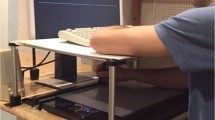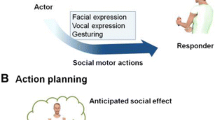Abstract
Understanding who owns what is important for guiding appropriate action in a social context. Previously, we demonstrated that ownership influences our kinematic patterns associated with hand–object interactions (Constable et al. in Cognition 119(3):430–437, 2011). Here, we present a series of experiments aimed at determining the underlying mechanisms associated with this effect. We asked participants to lift mugs that differed in terms of ownership status (Experiments 1 and 2) and personal preference (Experiment 3) while recording spatial and acceleration measures. In Experiment 1, participants lifted their own mug with greater acceleration and drew it closer to themselves than they did the experimenter’s mug. They also lifted the experimenter’s mug further to the right compared with other mugs. In Experiment 2, spatial trajectory effects were preserved, but the acceleration effect abolished, when the owner of the ‘other-owned’ mug was a known—but absent—confederate. Experiment 3 demonstrated that merely choosing to use a mug was not sufficient to elicit rightward drift or acceleration effects. We suggest that these findings reflect separate and distinct mechanisms associated with socially related visuomotor processing.




Similar content being viewed by others
References
Alexopoulos T, Muller D, Ric F, Marendaz C (2012) I, me, mine: automatic attentional capture by self-related stimuli. Eur J Soc Psychol 42(6):770–779
Anderson ML, Richardson MJ, Chemero A (2012) Eroding the boundaries of cognition: implications of embodiment. Top Cogn Sci 4(4):717–730
Becchio C, Sartori L, Bulgheroni M, Castiello U (2008) Both your intention and mine are reflected in the kinematics of my reach-to-grasp movement. Cognition 106(2):894–912
Beggan JK (1992) On the social nature of nonsocial perception: the mere ownership effect. J Personal Soc Psychol 62(2):229–237
Beggan JK, Brown EM (1994) Association as a psychological justification for ownership. J Psychol 128(4):365–380
Belk RW (1988) Possessions and the extended self. J Consum Res 15(2):139–168
Bell PA, Yee LA (1989) Skill level and audience effects on performance of a karate drill. J Soc Psychol 129(2):191–200
Borghi AM (2005) Object concepts and action. In: Pecher D, Zwaan RA (eds) Grounding cognition: The role of perception and action in memory, language, and thinking. Cambridge University Press, Cambridge
Borghi AM, Cimatti F (2010) Embodied cognition and beyond: acting and sensing the body. Neuropsychologia 48(3):763–773
Chen M, Bargh JA (1999) Consequences of automatic evaluation: immediate behavioral predispositions to approach or avoid the stimulus. Personal Soc Psychol Bull 25(2):215–224
Cohen J (1988) Statistical power analysis for the behavioral sciences. Lawrence Erlbaum Associates, Hillsdale
Constable MD, Kritikos A, Bayliss AP (2011) Grasping the concept of personal property. Cognition 119(3):430–437
Constable MD, Bayliss AP, Tipper SP, Kritikos A (2013) Self-generated cognitive fluency as an alternative route to preference formation. Conscious Cogn 22(1):47–52
Cunningham SJ, Turk DJ, Macdonald LM, Macrae CN (2008) Yours or mine? Ownership and memory. Conscious Cognit 17(1):312–318
Cunningham SJ, Van den Bos MB, Turk DJ (2011) Exploring the effects of ownership and choice on self-memory biases. Memory 19(5):449–461
Fischer P, Krueger JI, Greitemeyer T, Vogrincic C, Kastenmüller A, Frey D, Heene M, Wicher M, Kainbacher M (2011) The bystander-effect: a meta-analytic review on bystander intervention in dangerous and non-dangerous emergencies. Psychol Bull 137(4):517–537
Garza JP, Eslinger PJ, Barrett AM (2008) Perceptual-attentional and motor-intentional bias in near and far space. Brain Cognit 68(1):9–14
Georgiou I, Becchio C, Glover S, Castiello U (2007) Different action patterns for cooperative and competitive behaviour. Cognition 102(3):415–433
James W (1890) The principles of psychology, vol 1. Henry Holt and Co., New York
Kanngiesser P, Hood B (2014) Not by labor alone: considerations for value influence use of the labor rule in ownership transfers. Cogn Sci 38(2):353–366
Kim K, Johnson MK (2012) Extended self: medial prefrontal activity during transient association of self and objects. Soc Cogn Affect Neurosci 7(2):199–207
Kritikos A, Dozo N, Painter D, Bayliss A (2012) Mountain high, valley low: direction-specific effects of articulation on reaching. Q J Exp Psychol 65(1):39–54
Loftus GR, Masson MEJ (1994) Using confidence intervals in within-subject designs. Psychon Bull Rev 1(4):476–490
Lugli L, Baroni G, Gianelli C, Borghi AM, Nicoletti R (2012) Self, others, objects: how this triadic interaction modulates our behavior. Mem Cognit 40(8):1373–1386
Markman AB, Brendl CM (2005) Constraining theories of embodied cognition. Psychol Sci 16(1):6–10
Merrill TW (1998) Property and the right to exclude. Neb Law Rev 77:730–755
Milner AD, Brechmann M, Pagliarini L (1992) To halve and to halve not: an analysis of line bisection judgements in normal subjects. Neuropsychologia 30(6):515–526
Niedenthal PM, Barsalou LW, Winkielman P, Krauth-Gruber S, Ric F (2005) Embodiment in attitudes, social perception, and emotion. Personal Soc Psychol Rev 9(3):184–211
Palamar M, Le DT, Friedman O (2012) Acquiring ownership and the attribution of responsibility. Cognition 124(2):201–208
Riddoch MJ, Humphreys GW (1983) The effect of cueing on unilateral neglect. Neuropsychologia 21(6):589–599
Sartori L, Becchio C, Bulgheroni M, Castiello U (2009) Modulation of the action control system by social intention: unexpected social requests override preplanned action. J Exp Psychol Hum 35(5):1490–1500
Savelsbergh GJP, Steenbergen B, van Der Kamp J (1996) The role of fragility information in the guidance of the precision grip. Hum Mov Sci 15(1):115–127
Snyder AL, Anderson-Hanley C, Arciero PJ (2012) Virtual and live social facilitation while exergaming: competitiveness moderates exercise intensity. J Sport Exerc Psychol 34(2):252–259
Turk DJ, van Bussel K, Brebner JL, Toma AS, Krigolson O, Handy TC (2011a) When “it” becomes “mine”: attentional biases triggered by object ownership. J Cogn Neurosci 23(12):3725–3733
Turk DJ, van Bussel K, Waiter GD, Macrae CN (2011b) Mine and me: exploring the neural basis of object ownership. J Cogn Neurosci 23(11):3657–3668
Turk DJ, Brady-van den Bos M, Collard P, Gillespie-Smith K, Conway MA, Cunningham SJ (2013) Divided attention selectively impairs memory for self-relevant information. Mem Cognit 41(4):503–510
Valdés-Conroy B, Román FJ, Hinojosa JA, Shorkey SP (2012) So far so good: Emotion in the peripersonal/extrapersonal Space. PLoS one 7(11):1–8
van Dantzig S, Pecher D, Zwaan RA (2008) Approach and avoidance as action effects. Q J Exp Psychol 61(9):1298–1306
van den Bos M, Cunningham SJ, Conway MA, Turk DJ (2010) Mine to remember: the impact of ownership on recollective experience. Q J Exp Psychol 63(6):1065–1071
Acknowledgments
This research was supported by a University of Queensland Research Scholarship (Constable) and Australian Research Council Discovery Grants (to Kritikos, Slaughter, Sofronoff & Bayliss—DP130100253; Lipp—DP110100460). The authors would like to thank Hayley Colman and Harriet Dempsey-Jones for volunteering as confederates in Experiment 2. The authors would also like to thank Hayley Colman, Harriet Dempsey-Jones, and Samuel Sparks for lending their artistic skills to painting the mugs used in Experiment 3.
Author information
Authors and Affiliations
Corresponding author
Appendix
Appendix
See Table 2.
Rights and permissions
About this article
Cite this article
Constable, M.D., Kritikos, A., Lipp, O.V. et al. Object ownership and action: the influence of social context and choice on the physical manipulation of personal property. Exp Brain Res 232, 3749–3761 (2014). https://doi.org/10.1007/s00221-014-4063-1
Received:
Accepted:
Published:
Issue Date:
DOI: https://doi.org/10.1007/s00221-014-4063-1




